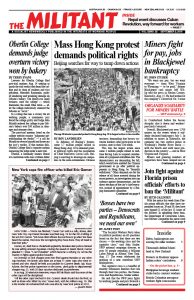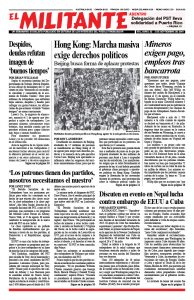AUCKLAND, New Zealand — Some 100 cops turned up in Ihumatao early on July 23 to evict a handful of protesters occupying historic Maori land that Fletcher Building, one of New Zealand’s largest companies, was set to turn into a housing development. “We are calling you all here to Ihumatao to come and stand with us to protect our whenua [land],” said Pania Newton, a leader of the occupation.
“When I heard the news on the radio, I drove my truck out here,” Koroheke, a truck driver, told the Militant as supporters gathered to face down the police lines. Over the next few days hundreds came from throughout Auckland and across the country, setting up an occupation camp. By the weekend there were thousands there, including some well-known musicians who put on a free concert.
Hundreds continued the occupation throughout the following week. And thousands turned out again the next weekend when an 800-strong delegation visited from the neighboring Waikato province. It was led by King Tuheitia, titular head of the Tainui tribal confederation, whose boundaries include Ihumatao. Support protests have taken place across the country.
This is the biggest action in support of Maori land rights in 15 years.
After first declaring July 23 that her government would not intervene, Prime Minister Jacinda Ardern announced a few days later, as the protests grew, that she had met with Fletcher Building bosses and arranged a halt to any construction on the site until further notice. Newton called on Ardern to visit Ihumatao and meet with representatives of Save Our Unique Landscape, the group organizing the occupation.
Confiscated land
Ihumatao was one of the first settlements established in New Zealand by Maori, the indigenous people here. It was confiscated by the New Zealand government in 1863. Government militias, backed by 12,000 British troops, invaded what is today the southern part of Auckland and much of the neighboring province of Waikato. This was the biggest military offensive against Maori in the l9th century New Zealand land wars.
“We have experienced ongoing injustices since Ihumatao was forcibly taken in 1863. Our ancestral lands have been quarried, our waterways polluted. We feel as though we have sacrificed enough for the greater good of Auckland, and all we’re asking for now is that this small piece of land is returned back to the guardians so that we can hold it in trust for all,” Newton told the London Guardian in an interview Aug. 3.
Save Our Unique Landscape was organized in 2015 by Newton and other Ihumatao residents in this predominantly Maori village of 80 households near Auckland airport. Newton and others have occupied the intended building site since Fletcher began setting out survey pegs in 2016.
Part of this coastal area, the Otuataua Stonefields, is a historic government-protected reserve. But 32 hectares nearby are private land purchased by Fletcher Building, which plans to construct 480 houses there.
“This fight isn’t just a fight for us and our kainga [village], it is for everyone to preserve this landscape,” said Erueti Rakena, addressing protesters in front of the police line July 24. Rakena, who grew up at Ihumatao, had come from Rotorua to be part of the protest and to answer those who claimed that elders were not supporting the action.
“The government stole the land; the government should give it back,” long-time Maori rights campaigner Tame Iti told the Militant Aug. 9 when he visited the Ihumatao occupation to extend solidarity.
As she campaigns door to door and at labor and social actions, Annalucia Vermunt, Communist League candidate for mayor of Auckland, has been building support for the battle at Ihumatao. “This fight sets an example for all working people of how we can unite and stand up to the capitalist bosses, their courts and their government when they try to ride roughshod over us,” she said. “It shows how it falls to working people to defend our rights and our cultural legacy.”

